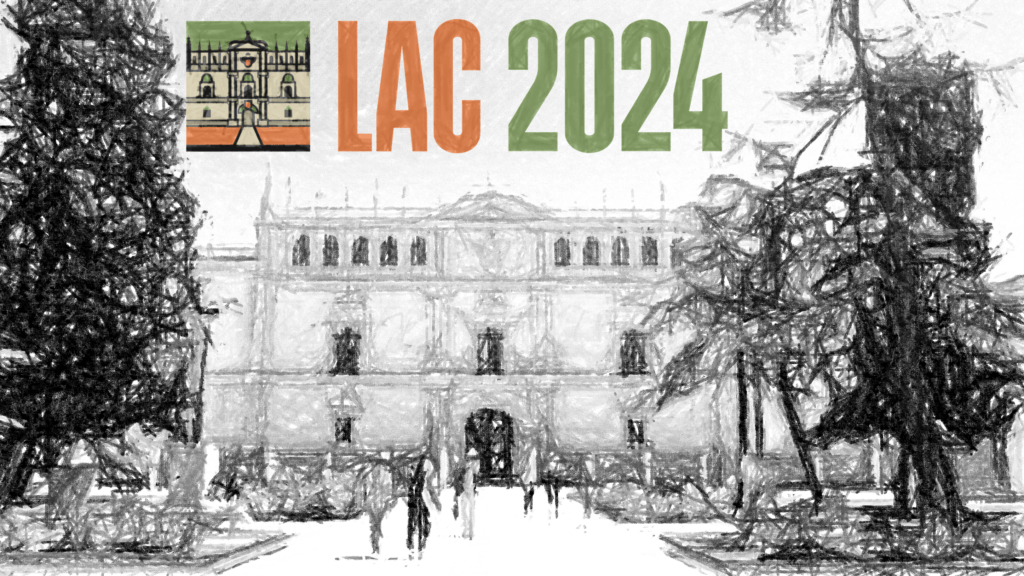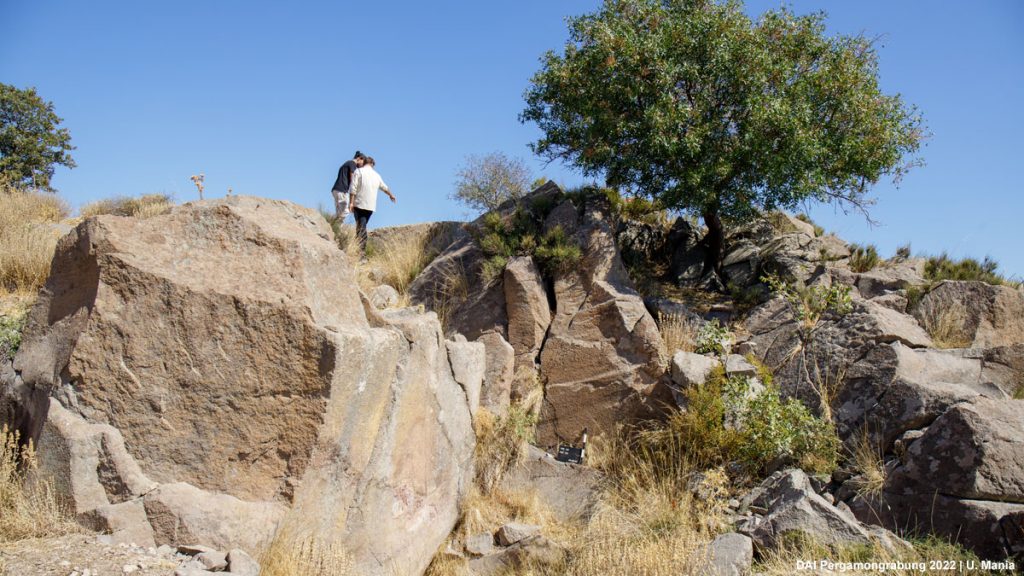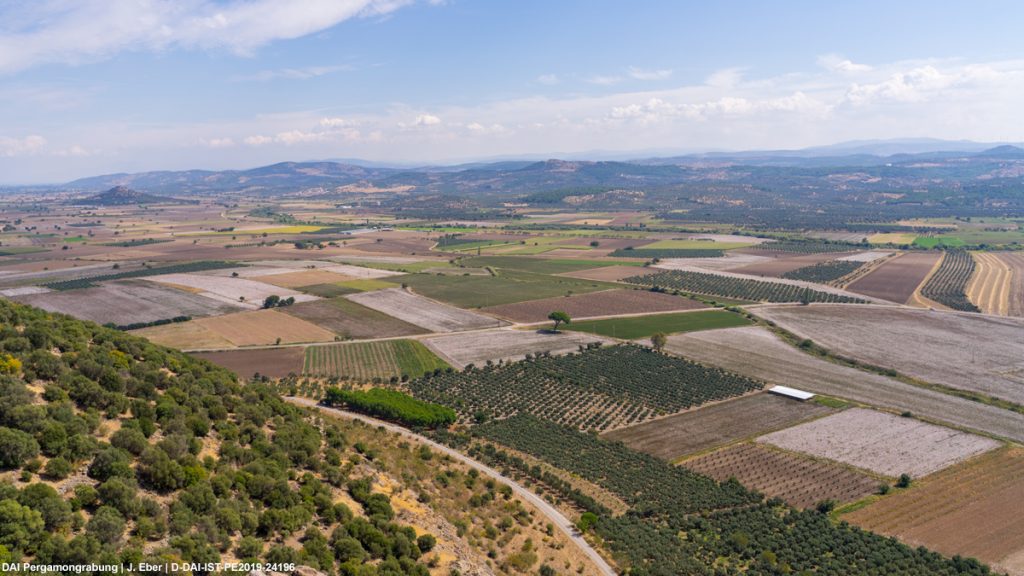
Wolf-Rüdiger Teegen and Nicole Neuenfeld
Burials within settlements have a long tradition in the ancient Near East. In the aceramic Neolithic, burials inside houses were common, as Nevali Çori (10th/9th millenium BCE), Çatalhöyük (mostly 7th millenium BCE), and other settlements from eastern Anatolia and the Levant demonstrate. During the Neolithic, first cemeteries outside settlements were forming. Only one group of humans was more or less continuously buried within settlements (“intramural”): fetuses and neonates. For the Bronze and the Iron Ages, intramural burials of fetuses and neonates are common in Anatolia and the Aegean, until this custom ends around 700 BCE in the late Geometric period. For the Archaic, Classical and Hellenistic periods, intramural burials of this age group are quite unusual in Asia Minor, while the burial custom continues in Greece.
In the Roman period, this type of burial seems to be rare in Anatolia as well, while in Italy, it is frequently attested in the first millennium BCE and CE. In this context it is important to remember the words by two important ancient scholars. Gaius Plinius Secundus (Pliny the Elder; 23–79 CE) wrote in his famous “Natural History” (Hist nat. 7,72): “Hominem prius quam genito dente cremari mos gentium non est” (It is not the custom to cremate a deceased before his teeth are erupted). Fabius Planciades Fulgentius (late 5th/early 6th century CE) mentioned in his “Expositio sermonum antiquorum” (7) the term “suggrundaria”: “Priori tempore suggrundaria antiqui dicebant sepulchra infantium qui necdum quadraginta dies implessent, quia nec busta dici poterant, quia ossa quae conburerentur non erant“ (In earlier times, the ancients called sugrundaria the graves of infants who had not yet filled forty days, because they could not be called graves, because there were no bones to be burned).
For Roman times, intramural burials are well studied for the Roman West by Simon Kramis in his book “Tote in der Stadt” (Dead in the city; 2020). Point of departure were the human remains found during excavations in the Roman city Augusta Raurica (Augst/Kaiseraugst, Switzerland). Most of these remains belonged to individuals who died perinatally. Comparing intramural burials from Augusta Raurica and other sites with contemporaneous cemeteries, the individuals buried in settlements seem slightly younger on average.
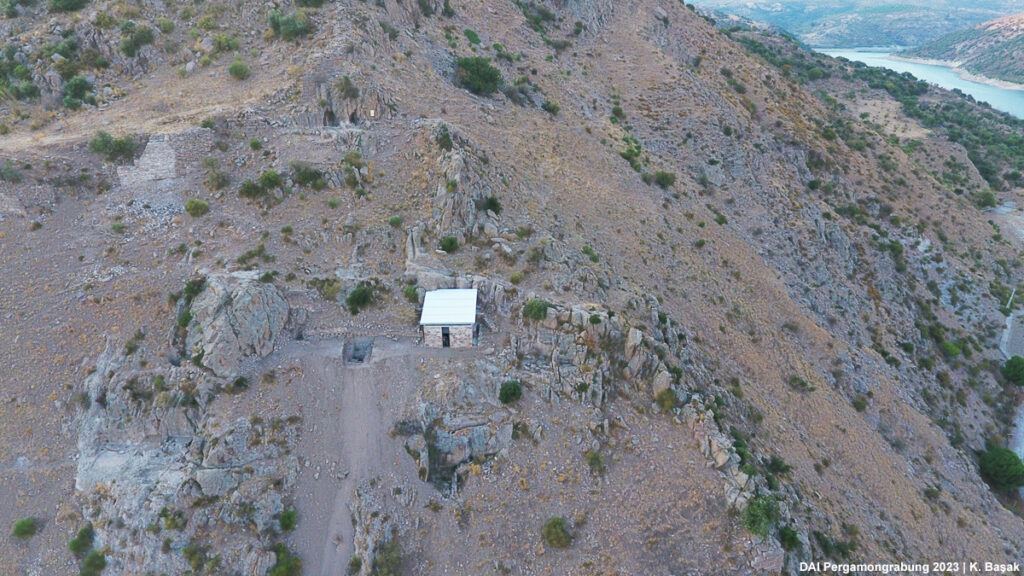
A case from Pergamon
During the field season 2022, Peggy Morgenstern and Michael Hochmuth analysed the animal bones from the so-called banqueting house (fig. 1. 2). Among the animal bones they identified human remains, which were studied by one of the authors (WRT).
The human remains recovered in 2022 belong to two individuals. The first is an individual who died perinatally (Ind. 1). Preserved are the nearly complete right humerus, the right distal radius, fragments of the right and left femur and the left tibia (fig. 3). All bones are fragmented, but otherwise relatively well preserved. They are quite gracile, which gives them a fetus-like look. The length of the humerus matches the average humerus length of a late fetus, who died between the 38th and the 40th gestational week (tab. 1), depending on the method used for age estimation (Schaefer et al. 2009). It was, however, a birth “in term”.
Due to the fragmentary character of the skeletal remains, no cause of death can be given, however, a natural cause seems very likely. Only in rare cases, pathological alterations of the skull, which is missing in our case, can give a possible diagnosis in the osteoarchaeological record, e. g. due to haemorrhages and/or inflammations of the meninges (Teegen – Schultz 1999).
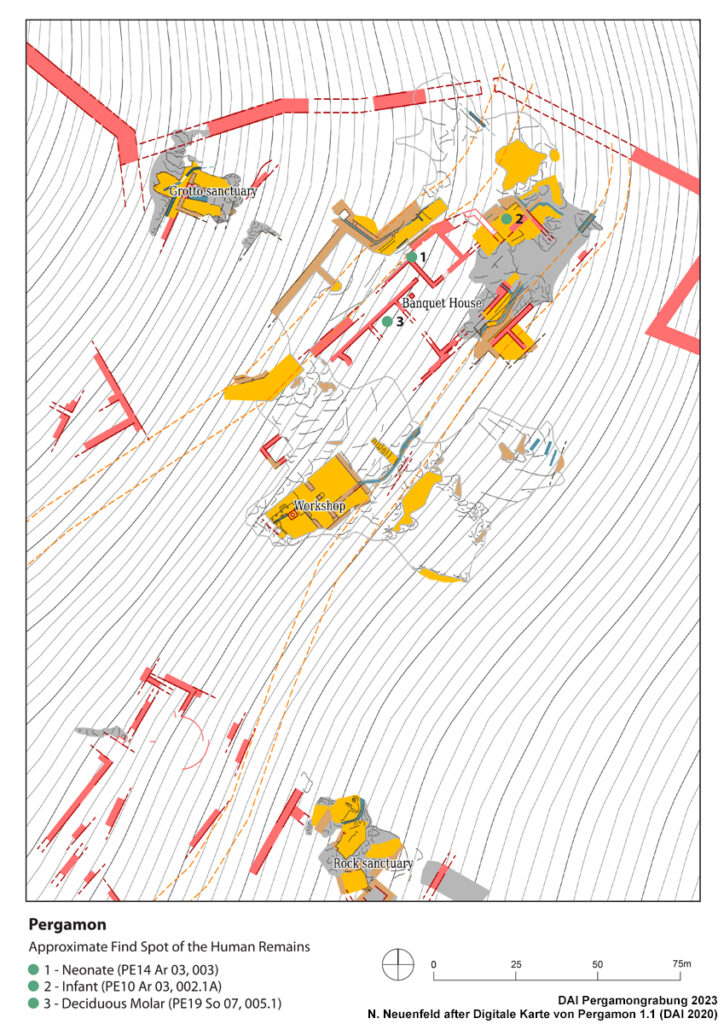
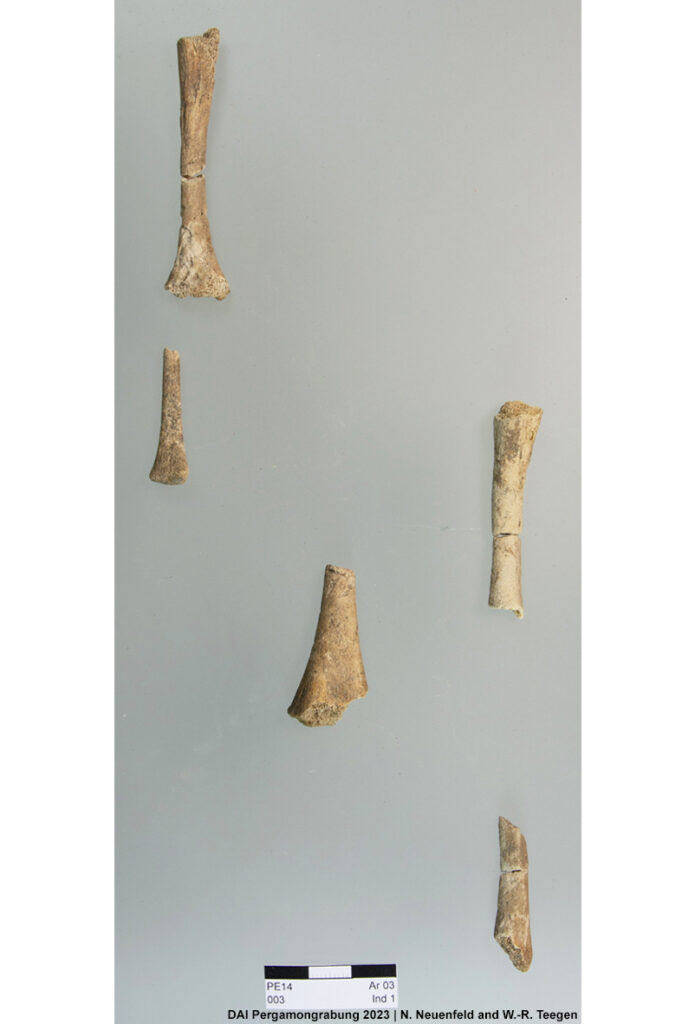
Fig. 3. (right) Late fetus or neonate (PE14 Ar 03, 003 Ind. 1). Preserved skeletal elements

Recent fractures suggest that the bones were complete before excavation. The fact that bones of the upper and lower extremities are present, indicates a more or less complete skeleton. This also implies a deposition of the corpse in the abandoned banqueting house, possibly during the 1st/2nd century CE (see below). The human remains were recovered in a layer with an almost complete waterjar, though it is not possible to be certain whether they were placed in the vessel, as is common in the south-east necropolis, or directly in the rubble. In Classical and Prehistoric archaeology, small bones are often not identified as human during the excavation, but only during the archaeozoological investigation, which was also the case in this study. For future fieldwork, this case study may serve as a cautionary tale, as more attention should be paid to accumulations of small bones.
The other fragment (Ind. 2) belongs to an older infant. Preserved is only one small fragment of the right parietal bone, close to the coronal suture. The thickness of the skull vault corresponds to an infant between 1 and 3 years of age (tab. 1). The archaeological context dates possibly into the 1st century CE.
During the 2021 campaign, a deciduous molar was identified, belonging to a child between 5 and 7 years of age (Ind. 3). It was probably lost during change of the dentition. The archaeological context dates to the late 1st century BCE or early 1st century CE.
The so-called banqueting house (Neuenfeld 2020 with further references) was built in the late 2nd or early 1st century BCE on the steep northern east slope of the city hill close to the Eumenean city wall below a road, wide enough to allow carts to pass (fig. 1. 2). In close proximity to natural sanctuaries, the banqueting house was not only used as a luxurious dining venue, which is evident from its architecture, well preserved wall decoration in the so-called First Style (Schwarz 2018), as well as remains of foods and tableware, but was probably utilised as a multifunctional building, as the discovery of a bathtub might suggest.
Following the abandonment of the building after barely 100 years of use in the early first century CE latest, it was stripped of its interior fittings and rubbish was dumped into the rooms from the road above, resulting in the frequent collapse of the building’s walls. At first glance, the waste material, accumulated together with the collapsed walls to a height of up to 5 metres (fig. 5), seems to originate from activities that took place in the surrounding area: large amounts of drinking vessels and terracotta figurines, as well as lead glazed pottery production waste and animal bones were continuously discharged during the 1st century CE and paint a colourful picture of a peripheral area that was used for artisanal, commercial and cultic activities.
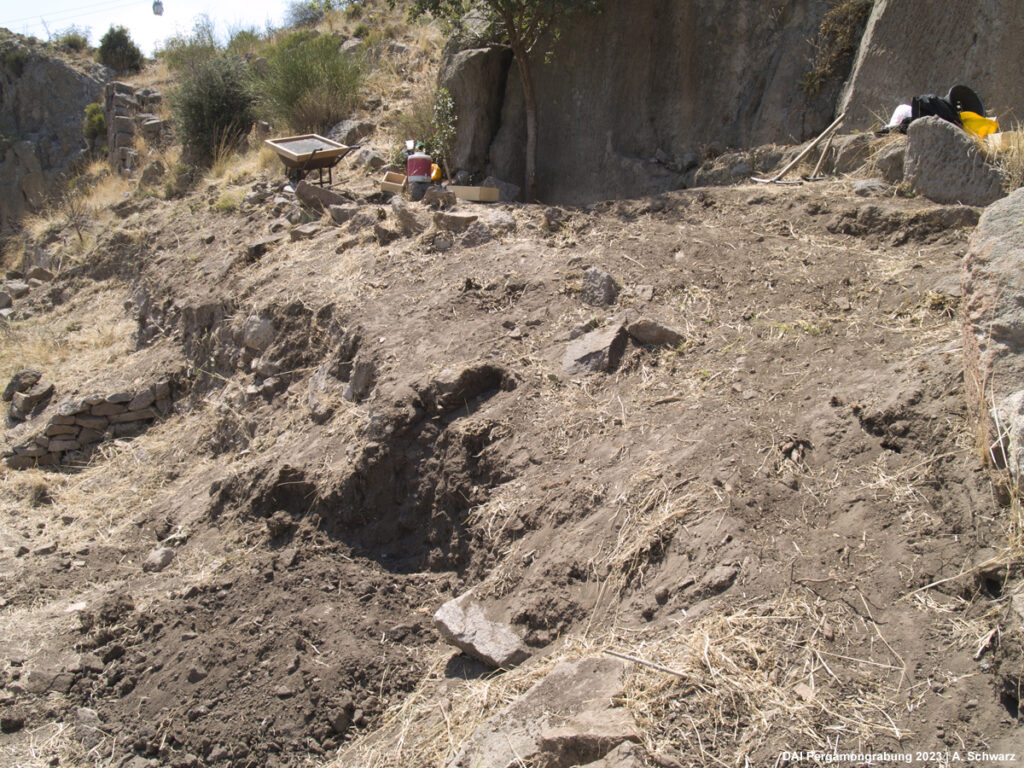
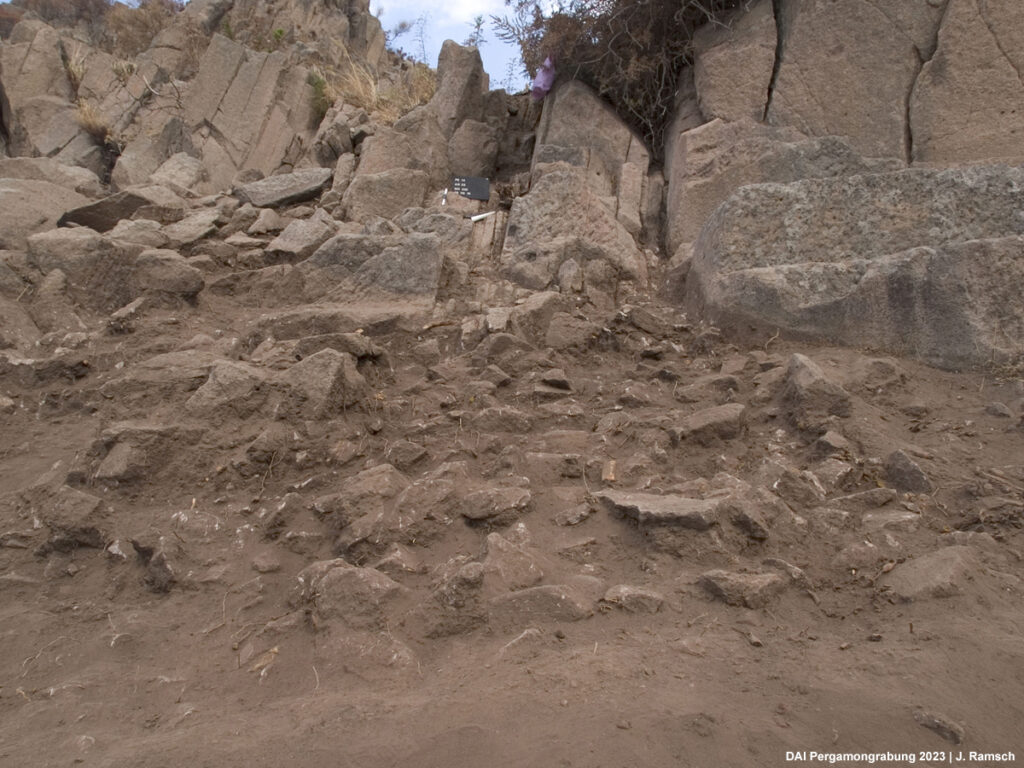
Fig. 5. (right) So-called banqueting house. Rubble and waste layer PE10 Ar 03, 002.1A including the infant’s skull fragment within the abandoned building
Discussion
In total, bone fragments of two infants and one child were recovered. The human remains of the neonate and the infant were found in layers above the massive waste layers of the early 1st century CE, but according to a first evaluation, the contexts still date to the 1st/2nd century CE. The find of a largely preserved waterjar with a possibly cut off neck, a common burial practice for neonates, in the context of the neonate bones makes a burial seem plausible. As described in the introduction, a late fetus or a neonate could well be expected as an intramural burial, also if contemporaneous examples are rare from Roman Asia Minor.
The deciduous molar could be lost after extraction and does not necessarily imply a burial. The skull fragment of the small infant tells a different story. In this case, a burial should be hypothesized. But which causes could lead to a burial of a 1-3-year-old child in an intramural ruin? This child could have fallen victim to a crime, some kind of accident, or even a natural hazard such as an earthquake. Though the dating of the context is not certain yet, severe earthquakes are attested for Pergamon, amongst others one in Trajan’s reign.
Regarding the contemporaneous Roman cemeteries of Pergamon (e. g. the south-east and south necropolises), neonates and small infants are present, but severely underrepresented, though perinatal and small infant mortality should have been highest. The burial site of all those small dead bodies is still unknown. Here, the ancient “suggrundaria” concept comes to mind: There could be areas outside the regular cemeteries for perinatal burials only and/or intramural burials.
The supposed burials are indicators of a shift in the perception of the intramural urban area, which, although not structurally used as a burial site, is an intriguing zone in the intraurban periphery of Pergamon that underwent a profound transformation from the Eumenian urban expansion to the 2nd century CE and beyond.
Acknowledgements
We are grateful to Dr. Peggy Morgenstern and Dr. Michael Hochmuth (DAI Berlin) for support.
References
Boz – Hager 2013
B. Boz – L. D. Hager, Intramural Burial Practices at Çatalhöyük, Central Anatolia, Turkey, in: Ian Hodder (ed.), Humans and Landscapes of Çatalhöyük. Reports from the 2000–2008 Seasons, Çatalhöyük Research Project Volume 8 (Los Angeles 2013) 413–440
Haddow et al. 2019
S. D. Haddow – J. W. Sadvari – C. J. Knüsel – S. V. Moore – S. E. Nugent – C. S. Larsen, Out of Range? Non-Normative Funerary Practices from the Neolithic to the Early Twentieth Century at Çatalhöyük, Turkey, in: T. K. Betsinger – A. B. Scott – A. Tsaliki – E. M. Murphy (eds.), The Odd, the Unusual, and the Strange. Bioarchaeological Explorations of Atypical Burials, Bioarchaeological Interpretations of the Human Past (Gainesville 2019) 323–346
Hürmüzlü 2005
B. Hürmüzlü, The Organization and Utilization of the Burial Grounds in Klazomenai, Olba 12, 2005, 39–67
Kramis 2020
S. Kramis, Tote in der Stadt. Anthropologische Untersuchungen von menschlichen Überresten aus dem Siedlungsareal der römischen Koloniestadt Augusta Raurica, Forschungen in Augst 53 (Augst 2020)
McGeorge 2017
P. J. P. McGeorge, The Pit L Baby Burial – Hermeneutics. Implications for Immigration into Kydonia in MMIII/LMI, in: R. Frederiksen – S. Handberg – K. Winther Jacobsen (eds.), Proceedings of the Danish Institute at Athens 8 (Aarhus 2017) 293–304
Neuenfeld 2020
N. Neuenfeld, Ausgrabungen im so genannten Banketthaus, in: F. Pirson, Pergamon. Das neue Forschungsprogramm und die Arbeiten in der Kampagne 2019, Archäologischer Anzeiger 2020/2, 2020, 162–170
Özgüç 1948
T. Özgüç, Die Bestattungsbräuche im vorgeschichtlichen Anatolien, Veröffentlichungen der Universität von Ankara 5 (Ankara 1948)
Schaefer et al. 2009
M. C. Schaefer – S. Black – L. Scheuer, Juvenile Osteology. A Laboratory and Field Manual (Amsterdam 2009)
Schwarz 2018
Eine hellenistische Dekoration im Mauerwerkstil aus Pergamon. Rekonstruktion und Einordnung in den lokalen und regionalen Kontext, in Y. Dubois – U. Niffeler (eds.) Pictores per Provincias II. Status quastionis. Actes du 13e colloque de l’Association Internationale pour la Peinture Murale Antique (AIPMA) (Basel 2018) 37–48
Teegen 2022
W.-R. Teegen, Die anthropologisch-paläopathologischen Untersuchungen 2021, in: F. Pirson, Pergamon – Bericht über die Arbeiten in der Kampagne 2021, Archäologischer Anzeiger 2022/2 (submitted).
Teegen – Schultz 1999
W.-R. Teegen – M. Schultz, Die Kinderskelete von der frühmittelalterlichen Wurt Elisenhof. Ergebnisse einer paläopathologischen Untersuchung, in: P. Westphalen – W.-R. Teegen – M. Schultz, Elisenhof. Die Ergebnisse der Ausgrabung der frühgeschichtlichen Marschensiedlung beim Elisenhof in Eiderstedt 1957/58 und 1961/64, Bd. 7, Offa-Bücher 80 = Studien zur Küstenarchäologie Schleswig-Holsteins A,7 (Neumünster 1999) 233–280, pl. 40–67

